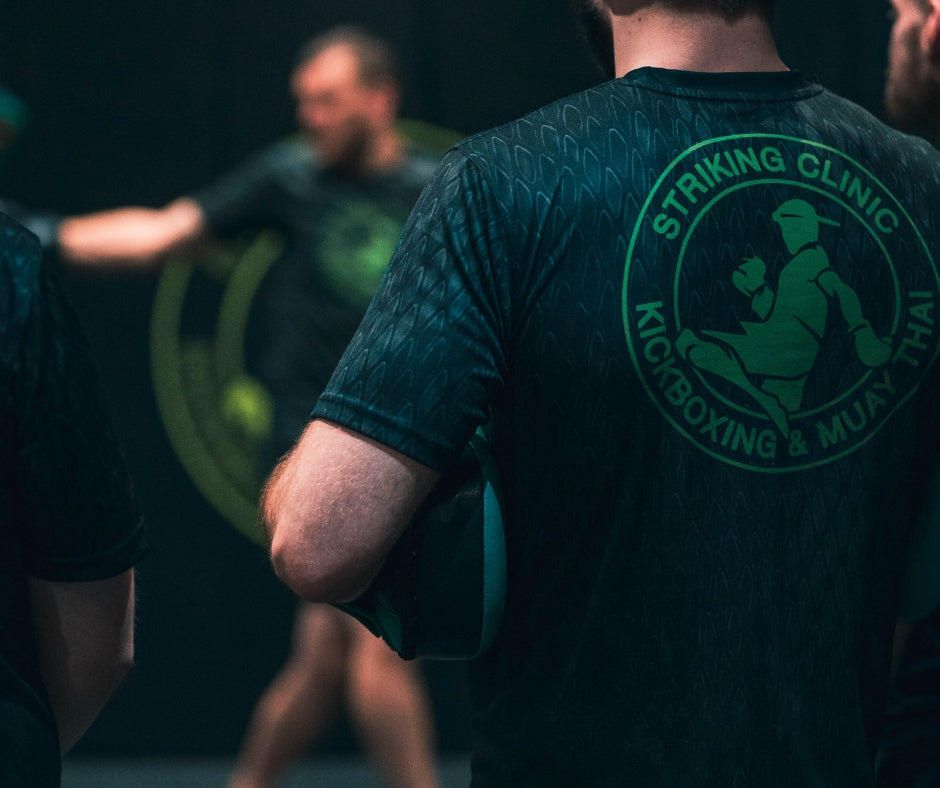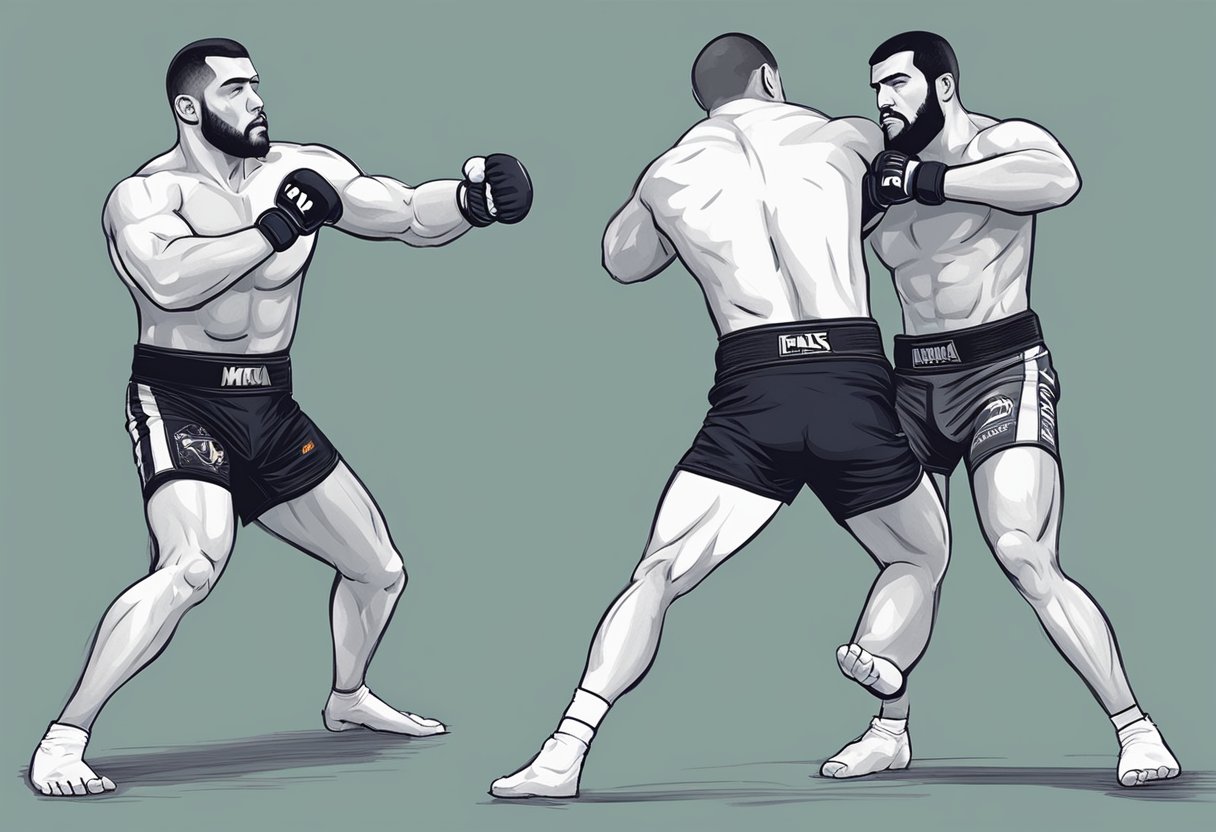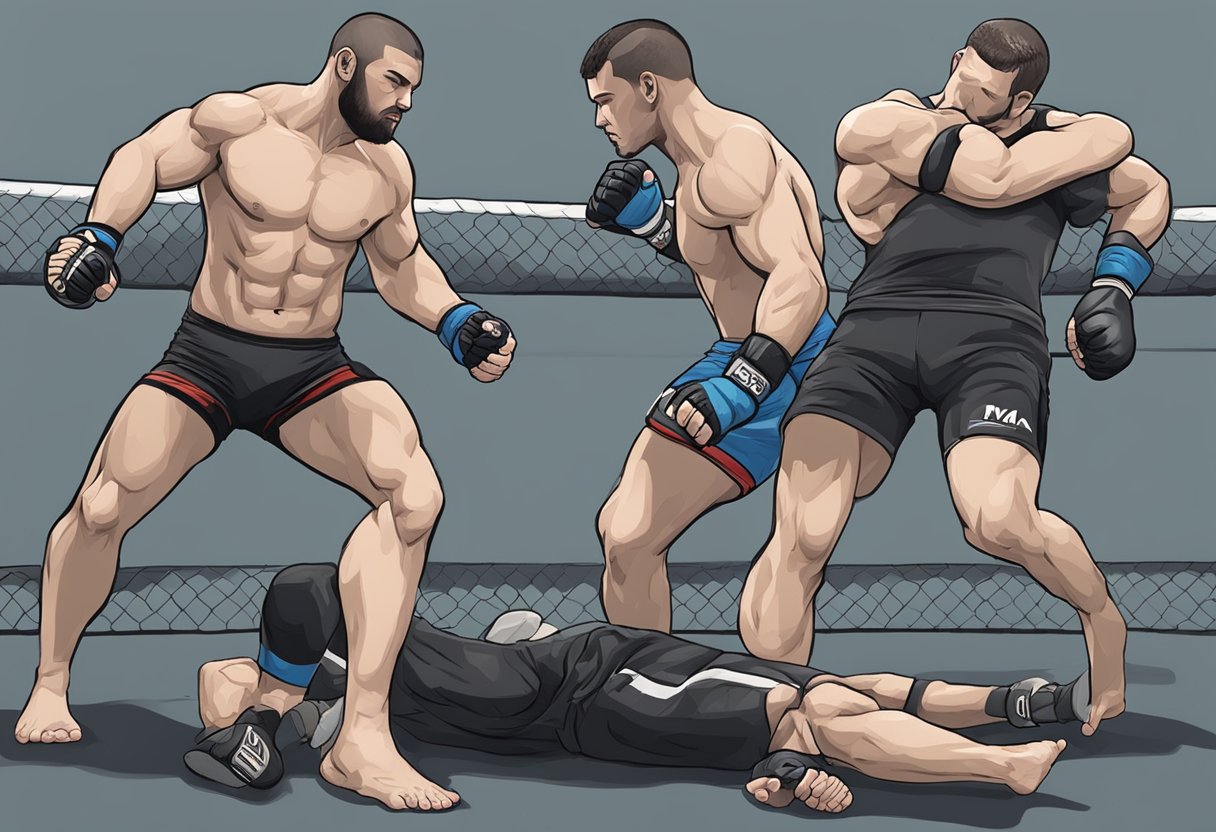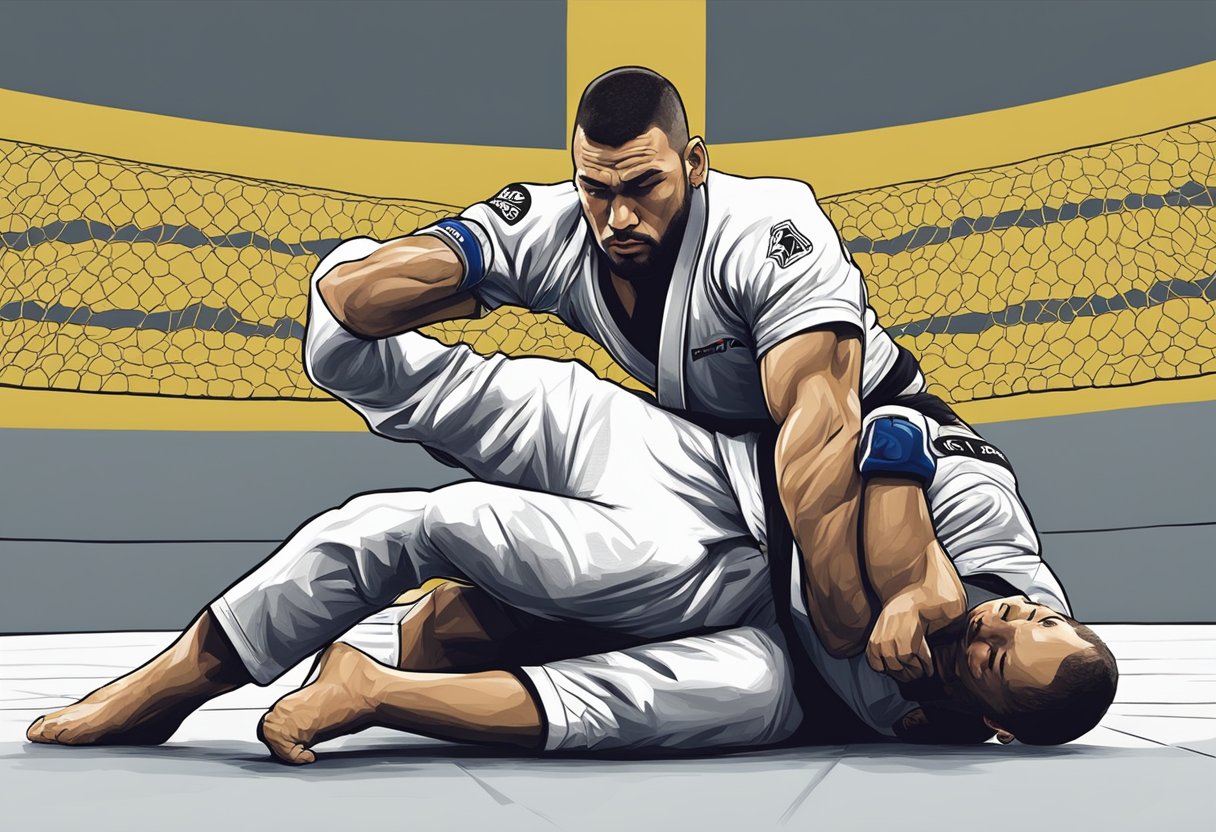
Common Submissions in MMA
Share
If you're a fan of mixed martial arts (MMA), you know that submissions are an essential part of the sport. A submission is when one fighter forces their opponent to tap out or lose consciousness by applying a joint lock or chokehold. In this article, we'll take a closer look at the most common submissions in MMA and why they're so effective.

The rear-naked choke (RNC) is by far the most superior and common submission in MMA. It's a blood choke that stops blood flow to the brain by squeezing the carotid arteries in the neck. The RNC has been used to finish fights at all levels of MMA, from amateur to professional, and is a staple in Brazilian Jiu-Jitsu (BJJ) and grappling competitions. Other submissions that are commonly used in MMA include the guillotine choke, armbar, and triangle choke.
Understanding MMA Submissions
In MMA, submissions are a key aspect of the sport. A submission is when a fighter forces their opponent to give up by tapping out or verbally submitting. This is done by using a variety of grappling techniques to control and manipulate an opponent's body.
Submissions can be initiated from a variety of positions, including standing, on the ground, or against the cage. Some of the most common submissions in MMA include the rear-naked choke, guillotine choke, armbar, triangle choke, and kimura.
Each submission has its own set of techniques and strategies for execution, making it important for fighters to be well-versed in a variety of submissions. Knowing how to execute a submission can be the difference between winning and losing a fight.
It's important to note that while submissions are a crucial part of MMA, they can also be dangerous if not executed properly. Fighters must be careful not to injure their opponent while attempting a submission, and must release the submission as soon as their opponent taps out or verbally submits.
Overall, understanding and executing submissions is an essential part of MMA. By mastering a variety of submissions and knowing when to execute them, fighters can gain a significant advantage in the octagon.
Most Common Submissions in MMA

If you want to become a successful MMA fighter, you must learn how to submit your opponent. Submissions are a vital part of MMA, and they can help you win a fight even when you are losing. Here are some of the most common submissions in MMA that you should know:
Rear-Naked Choke
The Rear-Naked Choke (RNC) is the most superior and common submission in MMA. It is a blood choke that stops blood flow to the brain by squeezing the carotid arteries in the neck. The RNC is responsible for almost 50% of all submissions in the UFC. It is a highly effective submission that can be applied from various positions.
Guillotine Choke
The Guillotine Choke is the second most common submission in MMA. It is an easy-to-attempt choke that can be secured from various positions. The Guillotine Choke is a type of front choke that involves wrapping your arm around your opponent's neck and applying pressure.
Armbar
The Armbar is a joint lock submission that targets the elbow joint. It involves hyperextending your opponent's arm until they tap out. The Armbar is a highly effective submission that can be applied from various positions.
Triangle Choke
The Triangle Choke is a type of choke that involves wrapping your legs around your opponent's neck and arm in a triangular shape. The Triangle Choke is a highly effective submission that can be applied from various positions.
Kimura
The Kimura is a joint lock submission that targets the shoulder joint. It involves twisting your opponent's arm until they tap out. The Kimura is a highly effective submission that can be applied from various positions.
Kneebar
The Kneebar is a joint lock submission that targets the knee joint. It involves hyperextending your opponent's knee until they tap out. The Kneebar is a highly effective submission that can be applied from various positions.
Anaconda Choke
The Anaconda Choke is a type of choke that involves wrapping your arm around your opponent's neck and applying pressure with your bicep. The Anaconda Choke is a highly effective submission that can be applied from various positions.
D'Arce Choke
The D'Arce Choke is a type of choke that involves wrapping your arm around your opponent's neck and applying pressure with your forearm. The D'Arce Choke is a highly effective submission that can be applied from various positions.
Ezekiel Choke
The Ezekiel Choke is a type of choke that involves using your sleeve to choke your opponent. The Ezekiel Choke is a highly effective submission that can be applied from various positions.
Von Flue Choke
The Von Flue Choke is a type of choke that involves using your shoulder to apply pressure to your opponent's neck. The Von Flue Choke is a highly effective submission that can be applied from various positions.
Inverted Triangle Choke
The Inverted Triangle Choke is a type of choke that involves wrapping your legs around your opponent's neck and arm in an inverted triangular shape. The Inverted Triangle Choke is a highly effective submission that can be applied from various positions.
Arm Triangle Choke
The Arm Triangle Choke is a type of choke that involves wrapping your arm around your opponent's neck and applying pressure with your bicep and forearm. The Arm Triangle Choke is a highly effective submission that can be applied from various positions.
Mae Hadaka Jime
Mae Hadaka Jime is a type of choke that involves wrapping your arm around your opponent's neck and applying pressure with your forearm. Mae Hadaka Jime is a highly effective submission that can be applied from various positions.
In conclusion, these are some of the most common submissions in MMA that you should know. Learning these submissions and how to apply them from various positions can help you become a successful MMA fighter.
Notable Fighters and Their Signature Submissions

When it comes to MMA, some fighters are known for their signature submissions. Here are a few notable fighters and the submissions they are known for:
-
Charles Oliveira: Oliveira is known for his grappling skills and has the most submission wins in UFC history. His signature submission is the anaconda choke, which he has used to finish multiple fights.
-
Jon Jones: Jones is a well-rounded fighter, but is particularly known for his wrestling. His signature submission is the guillotine choke, which he has used to finish several fights throughout his career.
-
Ronda Rousey: Rousey was a dominant force in women's MMA and was known for her judo skills. Her signature submission was the armbar, which she used to finish all but one of her professional fights.
-
Islam Makhachev: Makhachev is a highly skilled grappler and trains with Khabib Nurmagomedov. His signature submission is the rear-naked choke, which he has used to finish several fights.
-
Demian Maia: Maia is a Brazilian jiu-jitsu specialist and has some of the best grappling skills in MMA. His signature submission is the rear-naked choke, which he has used to finish multiple fights.
-
Anderson Silva: Silva is one of the greatest fighters of all time and is known for his striking skills. However, he also has a solid ground game and his signature submission is the triangle choke, which he has used to finish several fights.
-
Chael Sonnen: Sonnen is a wrestler and has solid grappling skills. His signature submission is the guillotine choke, which he has used to finish multiple fights.
-
Vicente Luque: Luque is a well-rounded fighter, but is particularly known for his striking. However, he also has a solid ground game and his signature submission is the D'Arce choke, which he has used to finish several fights.
-
Glover Teixeira: Teixeira is a Brazilian jiu-jitsu black belt and has solid grappling skills. His signature submission is the rear-naked choke, which he has used to finish multiple fights.
These are just a few examples of notable fighters and their signature submissions. In MMA, it's important to have a well-rounded skill set, but having a go-to submission can be a valuable tool in finishing fights.
Understanding Chokes and Their Variations

Chokes are one of the most common submissions in MMA. A choke is a submission hold that restricts the flow of blood or air to the brain, causing the opponent to lose consciousness. There are two types of chokes: blood chokes and air chokes.
Blood chokes, also known as strangulation chokes, work by compressing the carotid arteries in the neck, which supply blood to the brain. When these arteries are compressed, blood flow to the brain is reduced, causing the opponent to lose consciousness. Blood chokes are generally considered safer than air chokes because they do not put pressure on the windpipe, which can cause serious injury.
Air chokes, also known as tracheal chokes, work by compressing the windpipe, which restricts the flow of air to the lungs. This can cause the opponent to pass out due to lack of oxygen. Air chokes are generally considered riskier than blood chokes because they can cause serious injury to the windpipe and vocal cords.
The most common blood choke in MMA is the rear-naked choke, which is responsible for nearly 50% of all submissions in the UFC. The rear-naked choke works by wrapping one arm around the opponent's neck and applying pressure to the carotid arteries with the other arm.
Other common blood chokes include the guillotine choke, which is applied by wrapping the arm around the opponent's neck and squeezing, and the triangle choke, which is applied by wrapping the legs around the opponent's neck and arm and squeezing.
Air chokes are less common in MMA but can still be effective. The most common air choke is the anaconda choke, which is applied by wrapping one arm around the opponent's neck and the other arm around their arm and squeezing.
It is important to note that chokes can be dangerous and should only be applied under the supervision of a trained instructor. Improper application of a choke can cause serious injury or even death.
The Role of Submissions in UFC

The most common submission in UFC is the Rear-Naked Choke (RNC). This technique involves wrapping your arm around your opponent's neck and applying pressure to the carotid artery, causing a loss of consciousness. The RNC is a highly effective submission that can be applied from various positions, making it a versatile move for fighters to use.
In UFC events, fighters use submissions to gain an advantage over their opponents. A submission can be used to end a fight quickly, conserve energy, or even save a fighter from further injury. Some fighters specialize in submissions and are known for their ability to apply them in various situations.
UFC Fight Night events are also heavily influenced by submissions. These events often feature fighters who are skilled in submissions and use them to gain an advantage over their opponents. Some of the most memorable moments in UFC history have come from submissions, making them an integral part of the sport.
UFC submission data shows that the Rear-Naked Choke is the most successful submission in the sport. Other popular submissions include the Armbar, the Triangle Choke, and the Guillotine Choke. Fighters who are skilled in these submissions can use them to quickly end a fight and gain a victory.
In conclusion, submissions play a vital role in UFC and MMA. They are a powerful tool that fighters can use to gain an advantage over their opponents and end a fight quickly. The Rear-Naked Choke is the most successful submission in UFC, but other submissions can also be highly effective when used correctly.
Advantages and Disadvantages of Submissions

When executed correctly, submissions can be a highly effective way to end a fight in MMA. However, there are both advantages and disadvantages to using submissions.
Advantages
Gain an advantageous position
Successfully executing a submission can put you in a more advantageous position, such as gaining dominant control over your opponent. This could lead to a more favourable position for striking or setting up further submissions.
Target specific body parts
Different submissions target specific body parts, such as the arms or legs. This allows you to focus your attack on weaker areas of your opponent's body, potentially leading to a quicker submission.
Offensive strategy
Submissions can be a powerful offensive strategy, allowing you to control the pace and direction of the fight. By threatening with submissions, you can force your opponent to make defensive moves, which can open up opportunities for striking or takedowns.
Disadvantages
Risky position
Attempting a submission can put you in a risky position, especially if it fails. Your opponent may be able to escape and take control of the fight, potentially leading to a loss.
Requires close range
Most submissions require close range, which can be dangerous if your opponent is a skilled striker. Attempting a submission can leave you vulnerable to strikes, and it can be difficult to close the distance without taking damage.
Defensive strategy
Submissions can also be used defensively, but this can be risky if your opponent is skilled at escaping submissions. If your opponent is able to escape, you may end up in a worse position than before.
Limited effectiveness
Submissions are not always effective, especially against opponents with a high level of grappling skill. Against skilled opponents, it can be difficult to secure a submission, and even if you do, they may be able to escape or defend against it.
In summary, submissions can be a powerful tool in MMA, but they come with both advantages and disadvantages. It's important to weigh the risks and benefits before attempting a submission and to have a backup plan in case it fails.
The Impact of Brazilian Jiu-Jitsu on MMA Submissions

Brazilian Jiu-Jitsu (BJJ) has had a significant impact on the world of mixed martial arts (MMA) submissions. In the early days of MMA, BJJ practitioners dominated the competition with their ability to control and submit opponents on the ground. Royce Gracie, one of the early pioneers of BJJ, won the first two UFC tournaments with his superior ground game.
BJJ's emphasis on grappling and submissions has led to the development of many of the most common submissions in MMA. These include the rear-naked choke, armbar, and triangle choke, among others. BJJ's focus on positional control and submission techniques has also influenced other grappling arts, such as wrestling and judo.
Today, BJJ remains an essential component of any MMA fighter's training regimen. Many top MMA fighters, including Demian Maia and Fabricio Werdum, have extensive backgrounds in BJJ and continue to use it to great effect in the octagon.
Despite its effectiveness, BJJ is not without its limitations in MMA. As MMA has evolved, fighters have become more well-rounded and have developed strategies to neutralize BJJ's ground game. Fighters with strong wrestling skills, for example, can use takedowns and top control to avoid being submitted on the ground.
Overall, BJJ's impact on MMA submissions cannot be overstated. Its focus on grappling and submissions has led to the development of many of the most effective techniques in MMA, and it remains an essential component of any fighter's training.
Data Analysis of Submissions in MMA

When it comes to analysing data on submissions in MMA, the UFC is the best source to represent the most common submissions in the sport. This is because the UFC is the elite level of MMA, and the promotion has hosted the most events compared to other top MMA promotions.
According to data compiled by a Reddit user, the rear-naked choke (RNC) is the most successful submission in the UFC, with 523 recorded instances of the submission being used, taking up a massive 50% of the list. The guillotine choke is the second most common submission, with 147 recorded instances.
It's worth noting that submissions rank third amongst the most common ways for a fight to end, behind knockouts and decisions. Between 2014 and 2020, an average of 224 submissions occurred per year in the UFC, with the highest number of submissions occurring in 2015 (273) and the lowest in 2020 (158).
When looking at the different weight and gender categories, there are some variations in the most frequently-used submission techniques. For example, in the heavyweight division, the arm-triangle choke is the most common submission, while in the women's bantamweight division, the rear-naked choke is the most common submission.
In summary, the data shows that the rear-naked choke is the most successful submission in the UFC, and submissions are a relatively common way for fights to end. However, there are some variations in the most frequently-used submission techniques depending on weight and gender categories.
